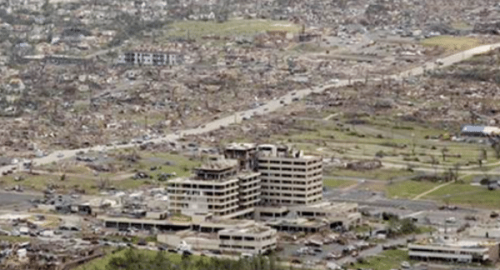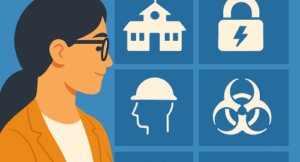In May 2011, a devastating EF-5 tornado—the classification for a tornado with at least 200 mph winds— tore through Joplin, Missouri. The tornado lasted 32 minutes and ultimately took the lives of over 160 people, including 7 students and one staff member from Joplin Schools. One of those students was a senior who just walked the stage and received his diploma less than an hour before the tornado struck.
“He was one of my most promising seniors,” recalled Dr. CJ Huff, the former Superintendent who handed the senior his diploma that day. “He had a really bright future ahead of him.”
In the hours, weeks, and years that followed, Dr. Huff successfully led the district through the many challenges that came with recovery. Having retired from Joplin Schools in 2015, he is now the Director of Strategy & Development of Safe and Sound Schools.
Dr. Huff recently spoke with Raptor about what he learned from that devastating storm. In the webinar, he shared the top three things he recommends schools do for weather-related emergencies. Our conversation is summarized below.
1. Build a K-12 Natural Disaster Response Plan
One of the most important components of response is being prepared before inclement weather or natural disasters impact your region. This requires you to think of the worst-case scenarios and accurately plan for them. Dr. Huff candidly shared, “I didn’t even know that a tornado was capable of that [level of destruction] … We did scenario-based planning. We thought through these things, and we did tabletop exercises… thinking that we could come up with the worst-case scenarios, but never in a million years would I have come up with a scenario like [the EF-5 tornado].”
He continued to expand on why it’s critical for schools to partner with other safety experts and organizations within their communities, like first responders and public safety officials. Working with these stakeholders—and your students, staff, and community members—can help you better think through worst-case scenarios and understand what threats your school faces. “The more people you bring to the table, the more comprehensive your plan is going to be,” he shared.
These stakeholders should also participate in training and drills. This helps get everyone on the same page and improve response in a real emergency. This also enables you to receive feedback on your drill performance and overall plan. Dr. Huff advised schools to also review their plans whenever there is a situation, whether it’s an incident in your school or something that happened at a district across the country. When reviewing the plan, the safety team should ask themselves, “What if that happened in our schools?”
2. Leverage Leadership, Resources, and Relationships
Having intentional relationships with your community and stakeholders can make all the difference. As Dr. Huff explained, “When you know how the police chief, [the] CEO of your electric company, and the CEO of both hospitals take their coffees…when you know how they think and they know how you think, it makes it easier to pick up the phone and say, ‘Hey. We need some help.’”
People from the district’s community also served as invaluable resources. Everyone’s focus, from the second the tornado struck to long after their schools reopened, was to make sure everyone was safe and supported. “One of the best things I did in the years leading up to the disaster, “Dr. Huff recalled, “is hire some amazing people on my leadership team… people who did everything they could do for our community.” The district also had many volunteers, as Dr. Huff explained, volunteerism “was the cornerstone of our work prior to the storm.” They helped with everything from cleaning up debris to writing thank you notes to donors.
Staff and students also needed mental health support and resources. “We put together a program leading up to what we knew was going to be a tidal wave of behavioral and mental health issues…as we came closer and closer to the [first year anniversary of the tornado], research had shown that’s when severe mental health issues start to resurface,” Dr. Huff shared. The district hired additional psychologists and school counselors and provided training to its community.
As part of its recovery and rebuild, the district used federal dollars to make safe rooms so people can take shelter in other storms. These safe rooms are open to the entire community, and it’s the staff’s responsibility to make sure dangerous individuals are supervised and/or kept separated from others (like keeping registered sex offenders away from minors). Talking about leveraging a visitor management system for operating a shelter, Dr. Huff said, “Having a quick way to [screen entrants], and if one of them gets flagged, at least knowing that they are there so you can keep your eyes on them… that’s important.”
3. Develop Communication Strategies
“Things are very different now than they were ten years ago in terms of technology,” Dr. Huff reminded us as he recalled how communication was jeopardized after the storm. Social media, like Facebook, was just starting to emerge, and cell phones were not as advanced as they are today. “When the cell phone towers went down, it was difficult—if not impossible—to make a phone call,” he shared. “I could text…but it would take 10 minutes to send a text. It was a mess.”
The district also used its school buses to help those in need, but communication was hindered and delayed the dispatch. “It took us 2-3 hours to be able to have good communication between the dispatchers, [our police and fire departments,] and the bus garage to get our fleet out,” Dr. Huff shared. Once able to communicate, some buses brought homeless people to shelters while others were dispatched to hospitals to evacuate patients.
It’s important to have backup communication plans and strategies. If your PA system fails, for example, a mobile panic button could make sure everyone is alerted of the incident. The most powerful mobile panic buttons enable users to initiate emergencies and communicate through group messaging from wherever they are located.
Learn More Weather Safety Tips
Responding and recovering from a severe weather event starts with creating a plan to keep everyone safe. To learn how to write your plan and be better prepared for weather-related emergencies, download Raptor’s Guide to K-12 Safety: Strategies for Effective Disaster Preparedness, Response, and Recovery.





